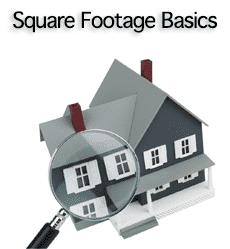 The square footage of a house is important when buying or selling a property. Many people have no idea how to measure a house in square feet because there is no mandatory standard. The standard set by the American National Standards Institute (ANSI) is voluntary so you should be careful with measurements, particularly when buying a house.
The square footage of a house is important when buying or selling a property. Many people have no idea how to measure a house in square feet because there is no mandatory standard. The standard set by the American National Standards Institute (ANSI) is voluntary so you should be careful with measurements, particularly when buying a house.
When buying a home, always keep in mind that the listing agent will try to get the highest possible price for the seller – the agent’s payment depends on the selling price of the property. The property will therefore be advertised in the most advantageous way to get the highest price, and that could mean expressing the square footage in the best way possible without being deliberately misleading.
Different people will measure a house in different ways, often according to why they are measuring it. Here are some of the problems and how they arise.
How to Measure a House
The square footage of a house is measured by multiplying the length by the breadth in feet, using the external measurements, not the internal sizes. Each floor is measured separately and added together, and if the property is not rectangular each shape is measured separately.
Only heated and residential areas should be used in the total. Thus, if upstairs and downstairs are both 1200 square feet, the total would be 2400 sq/ft. But what about the stair space? That should only be counted once, so should be deducted from the upstairs measurement.
Square Footage of a House – Garages and Porches
Should the floor space of garages and porches be included? Technically no, because only heated residential areas should be quoted. Some people will report the garage and porch separately as being unheated space, but what if the garage has a heater and a bunk bed installed? Some might also claim their heated porch to be a residential area.
Because there is no obligatory legal standard, it is little wonder that the dimensions of properties for sale have been subject to complaint after the sale has been completed. It is not only easy to misrepresent the square footage of a house, but not everybody agrees on how to measure it!
If you are buying a home, and its dimensions are important in terms of square footage, make sure you ask if unheated areas or porches and garages are included in the total. Be absolutely certain of what you are buying and also check that the stair area has not been counted twice.
Other errors known to occur involve people measuring downstairs then doubling it for a two-floor home. Not only does this double the stair area, but in the case of a vaulted area, where part of the ground floor rises up to the roof of the property, that is also being counted twice.
Ask How the House Was Measured
How do you overcome these problems when there is no agreement on how to measure a house? First, use your head and make sure you ask the relevant questions. Ask what the stated measurement includes. Also check comparable sales in your area for any difference between reported dimensions. When buying a home, you can ask your own agent or appraiser for this information before you make an offer.
There are other problems with regards to the square footage of a house, such as the terms ‘above’ and below’ grade for loft and basement conversions, and arguments over how to measure a house properly have reached a stage where many agents refuse to advertize square footage in case they are faced with a lawsuit for inaccuracy. Use your common sense and ask the right questions;
a) What is the square footage of a house for sale?
b) Are the garage and porch or any outbuildings included in that figure?
c) What exactly does the quoted area include?
Ask these questions and you should understand what the figure stated really means.


About The Author: Karengustin
More posts by karengustin